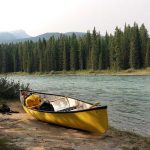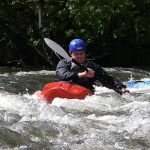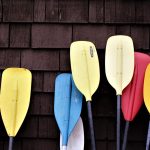Even though the whitewater kayaking industry is small, there are a lot of boat choices on the market. But don’t worry, none of the kayaks that CKS Online carries are bad. Some kayaks will be better or worse for beginners, and choosing the right one will make a big difference in how quickly you improve.
Types of kayaks
Historically, whitewater kayaks have been split into three categories.
Creek Boats (Creekers)
Creek boats are kayaks that are designed to be forgiving and easy to maneuver. They often have large volume and softer edges, making them perfect for running through tough rapids.
A creek boat is a great choice for a beginner who wants to accelerate the learning curve so that they can start feeling comfortable in a kayak as quickly as possible. Creek boats help keep you upright and make rapids that are challenging in other boats feel easier.
A recent trend among creek boats has been to make them longer and faster, with a design meant for racing. These boats are usually 9 feet long, and while they sacrifice stability for speed, they are faster than the traditional creek boats, which are usually 8 to 8 feet 10 inches long.
Playboats/Freestyle
Playboats are lower in volume than creek boats and have sharper edges. These characteristics make rapids more difficult to navigate but enable tricks to be performed while running rapids or surfing waves.
There are two main types of playboats: those designed for competition and those designed for carving turns.
Short, bulbous boats designed for surfing waves or holes are called competition playboats. They’re popular for play parks or competitions because they allow for big-air tricks.
The other style of playboat is a “full-slice,” which is longer and has a narrow, low-volume bow and stern. The longer shape allows for better river running and the low volume tip and tail make it easier to do tricks such as cartwheels or stern stalls.
Old school playboat designs from the early 2000s are making a comeback because they allow for a fun and unique style of paddling.
A playboat is not the best choice for a first kayak for many people because they are tough to paddle and lack stability. Although it is hard to learn in a playboat, it is not impossible.
If you’re motivated and willing to keep practicing even when you make mistakes, learning to paddle in a playboat will help you improve your technique and develop good habits that will make you a stronger paddler in the long term.
It can take 5 or more days on the water for many kayakers starting in a playboat to feel comfortable enough to truly enjoy paddling, while other boats might offer you the same comfort during day one or two.
Half-Slice Kayaks
A kayak with a high-volume bow and low-volume stern combines the best aspects of creek boats and playboats. This blend results in a kayak that is fun to paddle while still being able to perform well in downriver conditions.
Boat that are half the size of creek boats are usually just as long and have sharp edges that allow kayakers to go across the current. They are popular because they are fun and sporty on almost any river, but they still perform well in difficult rapids.
The front volume keeps your bow up, while the low-volume, “slicey” tail lets you quickly pivot the boat and do tricks such as stern stalls.
If you’re new to kayaking, a half-slice can be a great option. The sharper edges help with technique, while the high-volume bow and longer design provide stability so you don’t get too discouraged while learning.
Goals and Learning Style
The first step to buying a kayak is to think about what your goals are for kayaking. If you want to go kayaking a lot, you will need a different kind of kayak than someone who only wants to go a few times a month.
Although it can be frustrating, kayaking can be a rewarding sport to learn. Some boats make it difficult to start, but you learn better technique and have more room to advance. Other kayaks make it easy to start, but as you progress, the design can prevent you from improving your technique.
If you are looking to avoid flipping your kayak over, it is best to choose a more stable design. If you are willing to put in the extra effort required to learn in a smaller and less stable kayak, it will pay off in the long run with better technique.
Which Boat Is Best for Me?
The Liquid Logic Remix, Pyranha Burn, and the Jackson Zen (first and second generation) have all been top choices for beginners over the years because they offer stable and forgiving kayaks that make paddling feel easier.
Creek boats that are go-to options for beginners who are looking for something that will take care of them are the Pyranha Machno and Jackson Zen 3.0.
Half-slice boats are becoming increasingly popular among beginners as they offer greater stability and control. As kayakers develop their skills, they often find half-slice boats remain a fun and viable option.
If you’re looking for a kayak that is both loved by experts and beginners, the Pyranha Ripper, Dagger Rewind, and Liquid Logic Party Braaap are great choices. These kayaks offer a perfect mix of features that make paddling enjoyable without being too challenging.
The Jackson Antix is also a good choice for someone who is just starting out and is enthusiastic about learning.
While playboats aren’t ideal for most people, those who are willing to put in the effort and fall a lot before they succeed are rewarded with strong technical skills.
The Liquid Logic Homeslice and the Pyranha Ozone are good choices for a highly motivated beginner who wants to learn technical skills early on in their paddling.
These types of boats are often used by people who want to specifically train for freestyle kayaking.
How to Choose a Whitewater Kayak
Keep in mind that the following information is only a general guide and is not a replacement for finding out what works best for you through experimentation.
Design Features
Here is a description of a few different design features of a boat and how they will affect its paddling abilities.
Planing Hull vs. Displacement Hull
The two primary types of kayak hulls are planing and displacement. Planing hulls have a flat surface from edge to edge, while displacement hulls have a round curve that dips farther below the waterline and ‘displaces’ water. In general, rounder hulls hold a line better and are more forgiving – often because the rounder hull leads to a softer chine. All else being equal, displacement hulls tend to be a little faster than planing ones in flat water, while planing hulls may have an advantage in whitewater due to easier turning. Planing hulls tend to turn more quickly and be more maneuverable with less effort because they plane up on top of the water and thus don’t have to be pushed through the water to turn them.
Chines
The chines are the lower parts of a boat’s hull that extend below the waterline. In general, boats with harder chines are more performance-oriented, while boats with softer chines are more forgiving.
The bottom of the boat where it meets the water is called the chine. A hard chine is one where the angle between the bottom of the boat and the side is sharp, while a soft chine has a more rounded transition. Hard chines provide better maneuverability but can make the boat harder to control in certain conditions.
Soft-chined boats are more forgiving than boats with hard chines. You can still steer a soft-chined boat to some extent by the angle of your hips, but they are more likely to need to be pointed in the right direction before you start paddling. They work well in rocky water, but it can be more difficult to get them to where you want to go in big or aggressive water.
Some boats will have different types of chines on different parts of the boat to make some areas more performance-oriented and others more forgiving.
Rocker
The rocker is the curved edge on the ends of a boat’s hull. In general, less rocker makes the boat go faster by lengthening the waterline, while more rocker makes the boat more maneuverable by shortening it.
More rocker in the bow will make the boat ride better over features and transition better from vertical to horizontal when landing. Less rocker will make the boat less likely to ride over features and transition better from vertical to horizontal when landing.
The amount of rocker in a boat’s stern affects how well it performs when going over drops and how well it tracks and holds speed. If the chine on the stern comes inward toward the centerline more quickly than the rocker profile comes up, a boat with a low stern rocker might still boof well if it’s put on edge while releasing from the water, effectively increasing the stern rocker.
Volume
The volume of a kayak is the amount of water it would take to fill the kayak if it were submerged with the cockpit closed. In general, kayaks with a larger volume will float higher and be more forgiving, while smaller volume kayaks will allow for more play and a sportier ride.
While the total volume of the kayak is important to consider, the volume that is below the waterline is most important when selecting a kayak, as this is what will affect performance the most.A kayak with a planing hull will not float the same as a kayak with a displacement hull with the same total volume. Boats with similar lengths and volumes but different widths below the waterline will not float the same or be appropriate for the same people.
Displacement-hulled boats are slower than planing-hull boats, but they cost less to operate and can carry more weight. In general, longer and narrower boats go faster than shorter and wider boats, but longer boats are harder to turn. If two boats are the same length and width, the one with the longer waterline will usually be faster. Displacement-hulled boats are slower than planing-hull boats, but they cost less to operate and can carry more weight.
Other Essentials
Paddlers often refer to the 5 essentials
- Boat
- Paddle
- PFD (personal flotation device or lifejacket)
- Helmet
- Spray skirt
You only need these 5 pieces of gear to go river rafting.
Additionally, it is essential for beginners to have solid shoes and warm layers. They may spend some time in the water before they figure out how to paddle correctly.
We always recommend that you put float bags in the back of your kayak. If you fall out of your kayak, the float bags will keep it afloat. Float bags also make it easier to rescue your kayak and will prevent rocks from damaging it.



